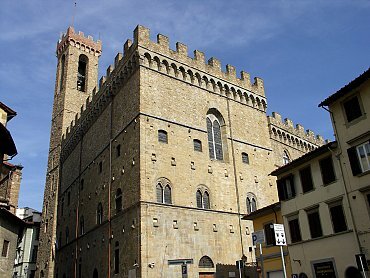Bargello National Museum: the story

The Bargello National Museum is the largest museum of Italian sculpture, and also the most important in the world for the Renaissance sculpture. It houses masterpieces by Michelangelo, Donatello, Ghiberti, Cellini, Giambologna, Ammannati and other important sculptors, as well as a large collection of applied arts.
The Bargello Palace is one of the oldest public buildings in Florence, whose origin is closely linked to the birth of municipal society. After Florence was constituted in free municipality, beginning therefore to coin its own money and heading into a period of great economic expansion, it was given a constitution that included a Mayor and a Captain of the People. It was therefore built this building (about 50 years before Palazzo Vecchio) to give a worthy seat to the Captain of the People.
The part overlooking via del Proconsolo is the oldest. Its project is attributed by Vasari to Lapo Tedesco, father and master of Arnolfo di Cambio, who incorporated existing structures including the palace and the Boscoli tower, but also other houses and towers of the Florentine Badia.
The work lasted for nearly a century, with the successive enlargements that include the construction of the arcaded courtyard, the scale with the balcony above, and the opening of elegant windows. Over the years, civil tumults, fire, natural disasters caused serious damage to the building and demanded repeatedly restorations.
The palace was the scene of political events that pitted the Papacy and the Empire, Guelph and Ghibellines, it witnessed the gradual decay of republican institutions .In the second half of the fifteenth century, with the assertion of Medici hegemony and the transfer of political power in the Palazzo Vecchio, it became the seat of the Council of Justice and from 1574, under Cosimo I de' Medici, it was transformed into a city jail. From the "Bargello" (police chief) who arrested, questioned and provided also to execute the sentences, the palace has derived the name it bears today.
In 1786, the Grand Duke Peter Leopold abolished the death penalty and the torture instruments in the building were burned. The prisons remained in use until the mid-nineteenth century, when they were transferred to the former Murate convent; thus began the complete restoration of the building, by Francesco Mazzei.
The establishment of the National Museum of the Bargello occurred in 1865, during the celebrations of Dante and it is the result of a long and controversial transformation. From that year many important sculptures of the Renaissance have been brought in the palace, including masterpieces by Donatello, Luca della Robbia, Michelangelo, Verrocchio and Cellini.
Today the museum has an extraordinary number of sculptural works so that it can be said that for Renaissance art lovers, the Bargello is to sculpture what the Uffizi is to the painting.











